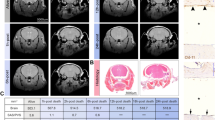Abstract
In the past, the arachnoid layer had been defined as a fine membrane in contact with (but not adhering to) the internal surface of the dura mater, and the subdural space had been described as a virtual space between the arachnoid layer and the dura mater, but this concept has since been modified. (See Chaps. 26 and 27). The arachnoid layer, a semipermeable membrane, exerts a barrier effect against the passage of substances across it. The thickness of the arachnoid measures about 35–40 μm, and it is composed of cells strongly bonded by specific membrane junctions. The intercellular space is thought to contain collagen fibers that reinforce this structure in order to increase its mechanical resistance
Access provided by Autonomous University of Puebla. Download chapter PDF
Similar content being viewed by others
Keywords
In the past, the arachnoid layer had been defined as a fine membrane in contact with (but not adhering to) the internal surface of the dura mater, and the subdural space had been described as a virtual space between the arachnoid layer and the dura mater, but this concept has since been modified. (See Chaps. 26 and 27). The arachnoid layer, a semipermeable membrane, exerts a barrier effect against the passage of substances across it. The thickness of the arachnoid measures about 35–40 μm, and it is composed of cells strongly bonded by specific membrane junctions [1–4]. The intercellular space is thought to contain collagen fibers that reinforce this structure in order to increase its mechanical resistance. From the outer towards the inner aspect of this membrane, four differentiated structures can be observed:
-
The outermost area is occupied by neurothelial cells, also known as dural border cells of the subdural compartment, which become the limits of “acquired subdural spaces” as the process of tearing extends across this layer.
-
Collagen fibers oriented in various directions compose the second distinctive area, occupying about 40–50 % of the total thickness of the arachnoid.
-
A basal membrane limits a third area filled with arachnoid cells that exert a barrier effect against the passage of substances. This layer comprises four or five cellular planes. These cells are light-colored and elongated, with a thickness of about 1.5–2 μm. The nucleus of these cells is large (1 μm wide by 7–9 μm); in their cytoplasm, the matrix contains fine reticular filaments oriented in different directions, endoplasm, numerous vesicles, and some mitochondria and lysosomes, with a few heterochromatin aggregates. The intercellular space is minimal in areas exerting barrier effect, forming narrow clefts of about 0.02–0.03 μm. Plasma membranes of neighboring cells join together by means of different types of specialized unions, such as tight junctions and desmosomes. The intercellular space lacks collagen, elastic fibers, or microfibrils.
-
The innermost area lies in direct contact with cerebrospinal fluid (CSF) and is formed by the reticular arachnoid, where arachnoid cells limit the subarachnoid space [5]. The intercellular space among these cells gradually increases owing to the absence of specialized membrane junctions, giving rise to small intercellular gaps that constitute the trabecular arachnoid extending across the subarachnoid space (Figs. 21.1, 21.2, 21.3, 21.4, 21.5, 21.6, 21.7, 21.8, 21.9, 21.10, 21.11, 21.12, 21.13, 21.14, 21.15, 21.16, 21.17, 21.18, 21.19, 21.20, 21.21, 21.22, 21.23, and 21.24).
Dissection of human dural sac during neurosurgical intervention (b from Reina et al. [1]; with permission)
View of human spinal arachnoid layer during neurosurgical intervention (b from Reina et al. [1]; with permission)
Spinal arachnoid layer. Transverse section of human spinal dural sac and spinal cord. Scanning electron microscopy. Magnification × 10 (From De Andrés et al. [5]; with permission)
Spinal arachnoid layer. Transverse section of human spinal dural sac and spinal nerve root at lumbar level. Detail of arachnoid layer. Scanning electron microscopy. Magnification × 170 (From Reina et al. [4]; with permission)
Spinal arachnoid layer, partial thickness. Detail of arachnoid cells and specialized membrane junctions. Transmission electron microscopy. Magnification: a, ×50,000; b, ×150,000 (b from Reina et al. [6]; with permission)
Spinal arachnoid layer, partial thickness. Detail of arachnoid cells and specialized membrane junctions. Transmission electron microscopy. Magnification: a, ×80,000; b, ×50,000 (a from De Andrés et al. [3]; with permission)
References
Reina MA, Prats-Galino A, Sola RG, Puigdellívol-Sánchez A, Arriazu Navarro R, De Andrés JA. Structure of the arachnoid layer of the human spinal meninges: a barrier that regulates dural sac permeability. Rev Esp Anestesiol Reanim. 2010;57:486–92.
Reina MA, Pulido P, López A. The human dural sac. Morphology of the spinal dura-arachnoid membrane. Origin of the spinal subdural space. Rev Arg Anestesiol. 2007;65:167–84.
De Andrés JA, Reina MA, Prats A. Epidural space and regional anaesthesia. Eur J Pain Suppl. 2009;3:55–63.
Reina MA, De Andrés JA, Hernández JM, Arriazu Navarro R, Durán Mateos EM, Prats-Galino A. Successive changes in extraneural structures from the subarachnoid nerve roots to the peripheral nerve, influencing anesthetic block, and treatment of acute postoperative pain. Eur J Pain Suppl. 2011;5:377–85.
De Andrés JA, Reina MA, Hernández JM, Carrera A, Oliva A, Prats-Galino A. Role of spinal anatomical structures for neuromodulation. Reg Anesth Pain Med. 2011;36:E130–8.
Reina MA, Oliva A, Carrera A, Durán Mateos EM, Diamantopoulos Fernández J, Arriazu Navarro R. Origin of post dural puncture headache. Cir May Amb. 2011;16:72–84.
Author information
Authors and Affiliations
Corresponding author
Editor information
Editors and Affiliations
Rights and permissions
Copyright information
© 2015 Springer International Publishing Switzerland
About this chapter
Cite this chapter
Reina, M.A., Pulido, P., De Sola, R.G. (2015). Ultrastructure of the Spinal Arachnoid Layer. In: Reina, M., De Andrés, J., Hadzic, A., Prats-Galino, A., Sala-Blanch, X., van Zundert, A. (eds) Atlas of Functional Anatomy for Regional Anesthesia and Pain Medicine. Springer, Cham. https://doi.org/10.1007/978-3-319-09522-6_21
Download citation
DOI: https://doi.org/10.1007/978-3-319-09522-6_21
Published:
Publisher Name: Springer, Cham
Print ISBN: 978-3-319-09521-9
Online ISBN: 978-3-319-09522-6
eBook Packages: MedicineMedicine (R0)




























